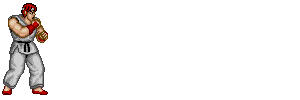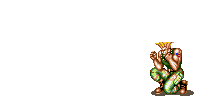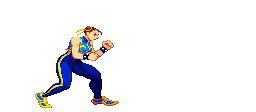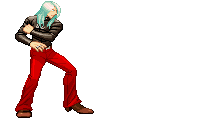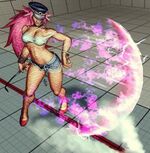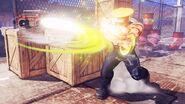(→Lore) Tag: Visual edit |
(→Trivia) |
||
| (7 intermediate revisions by 4 users not shown) | |||
| Line 7: | Line 7: | ||
Various types of projectile moves exist in the ''[[Street Fighter series|Street Fighter]]'' series, and allow users to damage foes from a distance. Depending on the projectile itself, it can also serve many other purposes, such as [[Zoning|controlling space]] and pressuring opponents. However, projectiles can be jumped over somewhat easily, depending on their orientation and positioning (which may require other options to avoid them as well). |
Various types of projectile moves exist in the ''[[Street Fighter series|Street Fighter]]'' series, and allow users to damage foes from a distance. Depending on the projectile itself, it can also serve many other purposes, such as [[Zoning|controlling space]] and pressuring opponents. However, projectiles can be jumped over somewhat easily, depending on their orientation and positioning (which may require other options to avoid them as well). |
||
| + | [[File:Sf4hd26.jpg|thumb|right|249px|Guile and Ryu firing a [[Sonic Boom]] and [[Hadoken]] respectively against each other in ''[[Street Fighter IV]]''.]] |
||
Since projectiles are a hitbox separate of the user and thus technically disjointed in a unique fashion compared to weapon-based hitboxes, they do not generate any physical pushback, meaning that a thrower of a projectile will not suffer any pushback themselves should they be used at close range on a cornered target on hit or block; this can normally be either a good thing or a bad thing depending on the context and situation. |
Since projectiles are a hitbox separate of the user and thus technically disjointed in a unique fashion compared to weapon-based hitboxes, they do not generate any physical pushback, meaning that a thrower of a projectile will not suffer any pushback themselves should they be used at close range on a cornered target on hit or block; this can normally be either a good thing or a bad thing depending on the context and situation. |
||
| Line 18: | Line 19: | ||
In the ''Street Fighter'' series, most characters tend to use both hands for their projectile shots. One handed projectiles are usually used by mentor type characters who has passed the technique down, such as [[Gouken]], who has shown the technique to Ryu and Ken, both characters who use both of their hands. [[Nash]] does the [[Sonic Boom]] with one hand, while the person he taught the technique to, Guile, uses both. [[Akuma]] uses both hands for ground Hadoukens but only one for his weaker air variant. |
In the ''Street Fighter'' series, most characters tend to use both hands for their projectile shots. One handed projectiles are usually used by mentor type characters who has passed the technique down, such as [[Gouken]], who has shown the technique to Ryu and Ken, both characters who use both of their hands. [[Nash]] does the [[Sonic Boom]] with one hand, while the person he taught the technique to, Guile, uses both. [[Akuma]] uses both hands for ground Hadoukens but only one for his weaker air variant. |
||
[[File:Vs181103-017.JPG|thumb|158x158px|An example of a single handed projectile. One handed projectiles tend to have less range than their two handed counterparts.]] |
[[File:Vs181103-017.JPG|thumb|158x158px|An example of a single handed projectile. One handed projectiles tend to have less range than their two handed counterparts.]] |
||
| − | Some characters with inexperience such as [[Dan]] and [[Ibuki]] use a single hand for their projectiles like [[Gadoken]] and [[Tenrai]] respectively. Dan is self taught and does not have full grasp of the Hado, while Ibuki never has received formal training, and her own |
+ | Some characters with inexperience such as [[Dan]] and [[Ibuki]] use a single hand for their projectiles like [[Gadoken]] and [[Tenrai]] respectively. Dan is self taught and does not have full grasp of the Hado, while Ibuki never has received formal training, and her own ki appears to come from herself as a person rather than her style of fighting, a style that prefers hand to hand and weapons such as [[Kunai]]. This can be seen in her Raida, where she uses one hand for her energy, and a whiffed [[Yoroitoshi]], where she forms a giant energy sphere that does not travel far. When Yoroitoshi connects it should be noted that she places her 2nd hand on the elbow of the arm that is on the opponent for stronger ki connection to her victim. |
[[Oni]] is an interesting example, the playable version's projectiles fizzle out. This is explained in canon by a portion of Akuma's soul still being alive within Oni and is holding back his full power. [[Boss Character|Boss]] Oni does not have this limit and his single handed projectiles are stronger than most other projectiles of the playable cast, including those that use both hands. |
[[Oni]] is an interesting example, the playable version's projectiles fizzle out. This is explained in canon by a portion of Akuma's soul still being alive within Oni and is holding back his full power. [[Boss Character|Boss]] Oni does not have this limit and his single handed projectiles are stronger than most other projectiles of the playable cast, including those that use both hands. |
||
| Line 51: | Line 52: | ||
[[File:ShinkuuHadoukenMVC3.jpg|150px|thumb|[[Ryu]]'s [[Shinku Hadoken]] in ''[[Marvel vs. Capcom 3: Fate of Two Worlds|Marvel vs. Capcom 3]]''.]] |
[[File:ShinkuuHadoukenMVC3.jpg|150px|thumb|[[Ryu]]'s [[Shinku Hadoken]] in ''[[Marvel vs. Capcom 3: Fate of Two Worlds|Marvel vs. Capcom 3]]''.]] |
||
| − | In most crossovers, projectiles are much larger, as are projectile-based [[Hyper Combo]]s; in the ''[[Marvel vs. Capcom series|Marvel vs. Capcom]]'' series the latter often take on a more beam-like appearance. Not to mention, several projectiles from this series onwards tend to have their own durability statistic; some projectiles can take longer to dissipate than others, while some beams despite passing through to the opponent, will still clash with a normal projectile with no damage to both opposing sides. Some projectile copies can also be thrown out without needing to have the prior copy leave the screen first. |
+ | In most crossovers, projectiles are much larger, as are projectile-based [[Hyper Combo]]s; in the ''[[Marvel vs. Capcom series|Marvel vs. Capcom]]'' series the latter often take on a more beam-like appearance. Not to mention, several projectiles from this series onwards tend to have their own durability statistic; some projectiles can take longer to dissipate than others, while some beams despite passing through to the opponent, will still clash with a normal projectile with no damage to both opposing sides. Some projectile copies can also be thrown out without needing to have the prior copy leave the screen first, likely due to increased mobility options. |
[[File:vs181106-001.JPG|150px|[[Poison]]'s projectile in ''Street Fighter X Tekken''.]] |
[[File:vs181106-001.JPG|150px|[[Poison]]'s projectile in ''Street Fighter X Tekken''.]] |
||
| − | In ''[[Street Fighter X Tekken]]'', one of the exceptions to the above, many ''[ |
+ | In ''[[Street Fighter X Tekken]]'', one of the exceptions to the above, many ''[[w:c:tekken:Tekken_(series)|Tekken]]'' characters are given moves that allow them to "sidestep" and avoid projectiles; this is due in part to the ''Tekken'' series' nature as a 3D fighter, and the relative lack of projectile users (and, therefore, lack of a proper defense besides blocking and/or the aforementioned sidestepping). |
| + | |||
| + | Some ''Tekken'' characters were also given some uncharacteristic projectiles and Ki such as Jin Kazama and Steve Fox. Both Lili and Ling Xiaoyu were also given Ki effects in their attacks and Xiaoyu even has an attack that resembles [[Tenrai]] in terms of hitbox properties and appearance. |
||
| + | |||
| + | ==Trivia== |
||
| + | *In more modern games, [[Rolento]]'s [[Stinger]] and [[Ibuki]]'s [[Kunai]] both function akin to projectiles, but are classified as strike hitboxes in the coding and they can be knocked away with regular attacks and projectile attacks that make contact (along with hitting through moves that possess projectile immunity). Though in Ibuki's case in all her pre-''SFIV'' appearances, they were classified as true projectiles similar to [[Cody]]'s [[Rock Throw]]. |
||
| + | |||
| + | ==Gallery== |
||
| + | <gallery> |
||
| + | Vs181230-009.jpg|Rose is an example of a character who uses an item as a proxy for projectiles rather than hands. |
||
| + | GuileBoomSF5.jpg |
||
| + | </gallery> |
||
[[Category:Attacks]] |
[[Category:Attacks]] |
||
[[Category:Special Attacks]] |
[[Category:Special Attacks]] |
||
Revision as of 06:58, 25 November 2019
| This article may or may not be a stub, but it's definitely missing something. Specifically: Expand the history section, particularly the Street Fighter Alpha series section. You can help the Street Fighter Wiki by giving us what we need. |
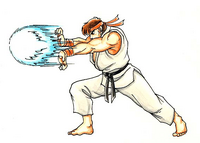
Street Fighter II artwork of Ryu firing a Hadoken.
A projectile, also generally referred to as a fireball, is a form of attack in various games, in which the user throws something - more often than not a shaped form of energy - at the opponent.
Description
The exact definition of a "projectile", as determined by the game engine, is "any attack that creates a moving hitbox separated from the character who performed the attack". Included within this is the ability to "cancel out" another such attack when two are onscreen at the same time.
Various types of projectile moves exist in the Street Fighter series, and allow users to damage foes from a distance. Depending on the projectile itself, it can also serve many other purposes, such as controlling space and pressuring opponents. However, projectiles can be jumped over somewhat easily, depending on their orientation and positioning (which may require other options to avoid them as well).
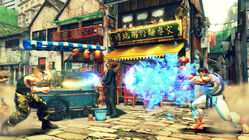
Guile and Ryu firing a Sonic Boom and Hadoken respectively against each other in Street Fighter IV.
Since projectiles are a hitbox separate of the user and thus technically disjointed in a unique fashion compared to weapon-based hitboxes, they do not generate any physical pushback, meaning that a thrower of a projectile will not suffer any pushback themselves should they be used at close range on a cornered target on hit or block; this can normally be either a good thing or a bad thing depending on the context and situation.
In other games, some projectile moves may be in the form of stationary ones that appear in a sudden area depending on the button used (and disappear after a brief moment if left untouched), while there exist moves that count as "energy" attacks (with a disjointed hitbox) that can both count as projectiles and negate projectiles as well. Overall, there exists a variety of projectile moves, as well as "beam" moves and several other variants with different properties.
In other fighting games, a vast number of projectiles often have their own durability rating; projectiles from Super Combos often would have one of their "hits" be taken off if they collided with another projectile, which may or may not completely negate them depending on the opposing projectile thrown. Thus, the typical projectile clashes/wars (or "fireball wars") may have varying results depending on the game and projectiles thrown in question.
In several prior fighting games, single copies of a projectile thrown from one person cannot be increased on the screen unless the prior projectile leaves the screen first or is destroyed via connecting/being blocked, preventing a form of spamming (not counting projectiles thrown from the opposing character). However, later fighting games can increase the number of projectile copies on-screen thrown by a single character.
Lore
In the Street Fighter series, most characters tend to use both hands for their projectile shots. One handed projectiles are usually used by mentor type characters who has passed the technique down, such as Gouken, who has shown the technique to Ryu and Ken, both characters who use both of their hands. Nash does the Sonic Boom with one hand, while the person he taught the technique to, Guile, uses both. Akuma uses both hands for ground Hadoukens but only one for his weaker air variant.
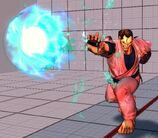
An example of a single handed projectile. One handed projectiles tend to have less range than their two handed counterparts.
Some characters with inexperience such as Dan and Ibuki use a single hand for their projectiles like Gadoken and Tenrai respectively. Dan is self taught and does not have full grasp of the Hado, while Ibuki never has received formal training, and her own ki appears to come from herself as a person rather than her style of fighting, a style that prefers hand to hand and weapons such as Kunai. This can be seen in her Raida, where she uses one hand for her energy, and a whiffed Yoroitoshi, where she forms a giant energy sphere that does not travel far. When Yoroitoshi connects it should be noted that she places her 2nd hand on the elbow of the arm that is on the opponent for stronger ki connection to her victim.
Oni is an interesting example, the playable version's projectiles fizzle out. This is explained in canon by a portion of Akuma's soul still being alive within Oni and is holding back his full power. Boss Oni does not have this limit and his single handed projectiles are stronger than most other projectiles of the playable cast, including those that use both hands.
Some characters can bypass the hand requirement with objects. Rose bypasses the hand requirement by using her signature scarf, her projectiles do not fizzle out over time neither. Dhalsim's Yoga Fire comes out of his mouth, and Poison's projectiles are used with her whip as a proxy. The latter two's projectiles do tend to fizzle out after a distance however.
History
Street Fighter
The Street Fighter series' first projectile moves were introduced with the very first game of the series. Ryu, Ken and their Hadoken would go on to become one of the series' many icons. Geki and Sagat, the final boss, were the only other fighter with projectiles, using a Shuriken throw and the famous Tiger Shot respectively. Sagat would become playable in single-player modes from Street Fighter II on.
Street Fighter II series
With the introduction of more characters into the series, several more projectile moves and users appeared, and opened up more varied combo tactics as a result.
The Hadoken played a major part in the divergence - both in the story and in gameplay - of Ryu and Ken. Ryu was shown to have gained more proficiency in the 'Hado' principle of his style, and thus was able to use more variants of the technique, including the Shakunetsu Hadoken and the Shinku Hadoken, his first and "trademark" Super Combo.
Street Fighter Alpha series
The mechanics for projectiles in the Street Fighter Alpha games made them much weaker within that series, though they were still quite useful in combos. The introduction of Rolento and Cody saw newer variations of projectiles not reliant on ki, making the use of small ordinance such as knives or even rocks.
Street Fighter III series
With the introduction of the parry mechanic, all users (particularly non-projectile users) gained an advantage against projectiles, being able to nullify them completely, as opposed to jumping, or blocking (and thus taking chip damage).
In addition, from this series on, the EX Special versions of most projectile moves hit twice, sometimes via firing two projectiles at once.
Crossovers

In most crossovers, projectiles are much larger, as are projectile-based Hyper Combos; in the Marvel vs. Capcom series the latter often take on a more beam-like appearance. Not to mention, several projectiles from this series onwards tend to have their own durability statistic; some projectiles can take longer to dissipate than others, while some beams despite passing through to the opponent, will still clash with a normal projectile with no damage to both opposing sides. Some projectile copies can also be thrown out without needing to have the prior copy leave the screen first, likely due to increased mobility options.
In Street Fighter X Tekken, one of the exceptions to the above, many Tekken characters are given moves that allow them to "sidestep" and avoid projectiles; this is due in part to the Tekken series' nature as a 3D fighter, and the relative lack of projectile users (and, therefore, lack of a proper defense besides blocking and/or the aforementioned sidestepping).
Some Tekken characters were also given some uncharacteristic projectiles and Ki such as Jin Kazama and Steve Fox. Both Lili and Ling Xiaoyu were also given Ki effects in their attacks and Xiaoyu even has an attack that resembles Tenrai in terms of hitbox properties and appearance.
Trivia
- In more modern games, Rolento's Stinger and Ibuki's Kunai both function akin to projectiles, but are classified as strike hitboxes in the coding and they can be knocked away with regular attacks and projectile attacks that make contact (along with hitting through moves that possess projectile immunity). Though in Ibuki's case in all her pre-SFIV appearances, they were classified as true projectiles similar to Cody's Rock Throw.

